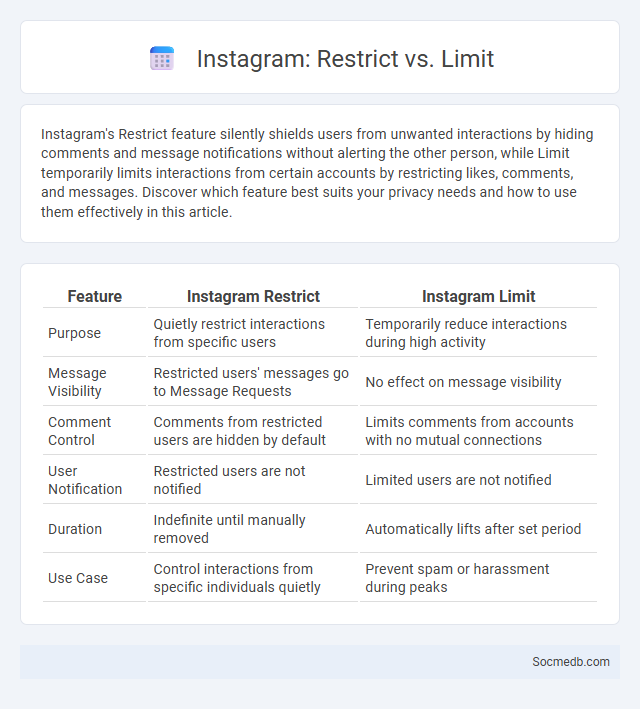
Photo illustration: Instagram Restrict vs Limit
Instagram's Restrict feature silently shields users from unwanted interactions by hiding comments and message notifications without alerting the other person, while Limit temporarily limits interactions from certain accounts by restricting likes, comments, and messages. Discover which feature best suits your privacy needs and how to use them effectively in this article.
Table of Comparison
| Feature | Instagram Restrict | Instagram Limit |
|---|---|---|
| Purpose | Quietly restrict interactions from specific users | Temporarily reduce interactions during high activity |
| Message Visibility | Restricted users' messages go to Message Requests | No effect on message visibility |
| Comment Control | Comments from restricted users are hidden by default | Limits comments from accounts with no mutual connections |
| User Notification | Restricted users are not notified | Limited users are not notified |
| Duration | Indefinite until manually removed | Automatically lifts after set period |
| Use Case | Control interactions from specific individuals quietly | Prevent spam or harassment during peaks |
Understanding Instagram’s Safety Features
Instagram's safety features include tools like comment filters, activity status controls, and two-factor authentication to protect your account and interactions. You can customize privacy settings to limit who sees your posts and story, enhancing control over your online presence. These features help maintain a safer environment by reducing harassment and unauthorized access on the platform.
What Does “Restrict” Mean on Instagram?
The "Restrict" feature on Instagram allows you to limit unwanted interactions without blocking someone entirely, providing a subtle way to protect your account from harassment or negativity. When you restrict a user, their comments on your posts become visible only to them and not to others, while messages from restricted accounts are filtered into your Message Requests. This option enhances your control over your social media experience, ensuring that your interactions remain positive and manageable.
Exploring the “Limit” Feature on Instagram
Instagram's "Limit" feature transforms your social media experience by allowing you to restrict interactions from unwanted followers or recent followers without blocking them entirely. You can protect your account from spam, harassment, and negative comments by customizing who can comment on or see your posts during specific periods. This tool enhances your control over privacy and engagement, ensuring your content reaches your intended audience while minimizing disturbances.
Key Differences: Restrict vs Limit
Restrict on social media typically means controlling who can see your content or interact with you by hiding posts and limiting engagement without notifying the other user. Limit, on the other hand, generally reduces the visibility of your content to certain users and restricts their ability to comment or message without completely blocking them. Understanding these features helps users manage privacy and maintain control over their online interactions more effectively.
When to Use Instagram Restrict
Using Instagram Restrict is ideal when you want to protect Your account from unwanted interactions without alerting the other party. Restrict limits visibility of comments and messages from specific users, reducing harassment discreetly. Activating this feature helps maintain a positive online environment by controlling who can affect Your posts and communication.
Advantages of Using Limit on Instagram
Implementing limits on Instagram usage can significantly enhance mental well-being by reducing screen time and minimizing exposure to negative content. Users benefit from increased productivity and better focus as they manage their social media engagement more effectively. Limiting Instagram access also fosters healthier digital habits, promoting real-life interactions and reducing digital fatigue.
Privacy and Control: How Each Feature Works
Social media platforms offer various privacy and control features such as customizable profile visibility, audience selection tools for posts, and detailed account activity logs to monitor access and interactions. You can manage your digital footprint by adjusting settings like friend approval, blocking, and content filtering to protect personal information and limit unwanted contact. These features work together to enhance your security, giving you precise control over who sees your content and how your data is shared.
Impact on User Interactions: Restrict vs Limit
Restricting social media features narrows user interactions by blocking specific accounts or content, reducing exposure to harmful or unwanted communication while preserving access to public conversations. Limiting interactions, such as reducing visibility of posts or restricting comments, subtly curtails engagement without a complete cutoff, fostering a more controlled and less overwhelming experience. Your ability to manage how you connect with others enhances online safety and personal well-being by balancing freedom of expression with protection from negativity.
Step-by-Step Guide to Restrict or Limit Accounts
To restrict or limit accounts on social media, start by navigating to the privacy or settings section of the platform you are using. Select the account or profile you wish to restrict, then choose the restriction option to limit interactions without fully blocking the user. This feature typically prevents comments from being visible to others and restricts direct messages, enhancing control over your online interactions.
Choosing the Right Tool for Online Safety
Selecting the right social media platform for online safety involves evaluating privacy settings, data encryption, and content moderation policies to protect user information effectively. Secure platforms like Signal and Telegram offer end-to-end encryption that minimizes the risk of unauthorized data access. Understanding each site's safety features, such as two-factor authentication and reporting mechanisms, ensures better protection against cyber threats and harassment.
 socmedb.com
socmedb.com